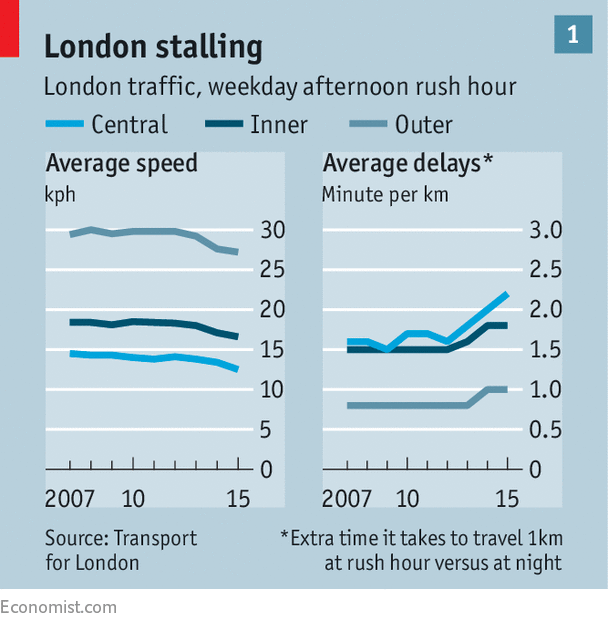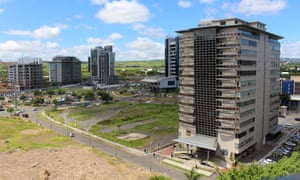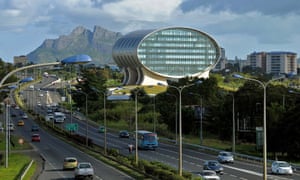How and why road-pricing will happen
As ride-sharing and electric cars take off, governments are seeking new ways to make drivers pay.
IN 1868 the world’s first traffic light was installed outside the Houses of Parliament. The gaslit signal controlled the flow of London carriages—at least for a few weeks. For, soon enough, the gas ignited. The resulting explosion knocked the helmet off a policeman’s head, and left him badly burned.
Efforts to ease congestion no longer literally blow up in your face, but recent schemes have run into trouble, too. In 2003 Ken Livingstone, then London’s mayor, introduced a congestion-charging zone (CCZ). Motorists pay up to £11.50 a day ($15.20) to drive into the centre of the city. Since 2000 the number of cars entering central London has fallen by nearly a quarter. But congestion is rising again (see chart 1), a result of vans and taxis clocking up more miles within the zone, as well as new lanes for buses and Lycra-clad commuters that have reduced the road space for cars. More minutes are lost to delays than before the CCZ. The average vehicle speed has fallen from 19.9 miles (32.0km) per hour in 2013 to 17.7mph (28.5kph) in 2016.

In response, London, like other heaving parts of the world, is looking at a more radical approach to reduce congestion. In January the London Assembly, the elected body that oversees the mayor, published a report calling for the city to develop a system of road-pricing that varies by when, how much and where drivers use the roads. Singapore, which already has the world’s most comprehensive road-pricing system, is introducing a new one in 2020 that uses cars’ global positioning systems (GPS) to charge motorists more precisely. Other schemes are being tried out in American states such as California and Oregon.
All of which pleases economists. Using prices to ration a scarce resource, such as space on busy roads at busy times, makes sense. Those who consume a good should pay for it. Road-pricing is also more efficient than the typical ways drivers are charged for imposing costs on others: taxes on fuel and on car ownership. Neither penalises driving in congested conditions, which causes extra pollution and crimps productivity by delaying workers and deliveries, and disrupting supply chains. And although congestion zones help, they are blunt instruments; ideally, road pricing would adjust to traffic flows in real time.
Yet economists are not normal people. Most voters hate taxes on driving. Even if they grudgingly accept existing ones, they squeal about any increases. In Britain, which Margaret Thatcher called a “great car-owning democracy”, duties on fuel have been frozen since 2011 following pressure from drivers’ groups. Nineteen American states have not raised their “gas taxes” in at least a decade; Oklahoma’s levy has been frozen for 30 years.
The not-so-fast and the furious
Many drivers would rather “pay” by queuing than through road-pricing. The Netherlands hoped to run a 60,000-vehicle trial of road-pricing in 2011, on the way to a nationwide scheme. But opposition politicians and motoring organisations fought so hard that the plans were dropped.
Governments will nevertheless soon have to find new ways of making drivers pay. That is not because congestion will worsen otherwise—though it will. Rather, tax revenue from motoring is drying up.
One reason for this is the spread of ride-hailing and ride-sharing. In London drivers for firms like Uber can circulate all day inside the CCZ, picking up fares, while being exempt from the charge. The number of private-hire vehicles that entered the zone at least once rose from 50,000 in March 2013 to 85,000 in November 2016. The number of licensed drivers rose from 67,000 to 115,500 over the same period. (In the future self-driving cars may replace these workers, further depleting government coffers, since there will be fewer car owners to tax.) In total private-hire vehicles make up 38% of car traffic in central London, almost double the share of traditional black taxis.
The second reason for dwindling revenue—increasingly efficient cars—is even more important. Cars’ fuel efficiency has roughly doubled in the past 25 years (see chart 2). Partly as a result, the tax take from fuel and vehicle duties in Britain has declined by £812m per year in real terms over the past five years, according to Gergely Raccuja, an economist who on July 13th won the Wolfson prize, an economics competition run by Policy Exchange, a British think-tank, for a paper on road taxation. During the same period the total amount of miles driven increased.

Electric vehicles will further widen the gap between traffic and taxes. Paal Brevik Wangsness of the Institute of Transport Economics in Norway, the country where electric-car ownership is highest, points out that electric vehicles not only incur no fuel duty, but often attract government subsidies. British drivers, for example, can get £4,500 off the cost of electric cars such as a Nissan Leaf or a Tesla Model X. Even if these types of subsidies fall as cars become cheaper, they will require infrastructure such as charging points and cables.
Get your motor runnin’
For Mr Raccuja, a fair and radical way to pay for the costs of car use would be to scrap duties on fuel and ownership, and replace them with a “road tax”. His new levy would be a per-mile charge that varied depending on a car’s weight and emissions, thereby making drivers with road-crushing and air-polluting vehicles pay more. Mr Raccuja notes that the charge could also be higher in more congested places.
Such schemes will doubtless infuriate motorists. But there are reasons to believe that a shift toward road-pricing is not just increasingly urgent, but also more plausible. London’s CCZ was brought in against stiff opposition. Today just one-fifth of Londoners oppose the idea of a more sophisticated road-pricing scheme, according to the London Assembly. After a seven-month trial in 2006, Stockholm residents voted narrowly by 53% to 47% to make the city’s congestion zone permanent. But by 2011 polls showed that about 70% of residents backed the scheme.
Car owners may become less of a political force, at least in cities, as people opt against getting behind the wheel. In many rich countries the share of 20-somethings with driving licences is falling. The number of car-less households in America declined from 1960, when the US Census began tracking it, until 2010, since when the tally has begun to tick up. McKinsey, a consultancy, estimates that one in ten vehicles sold by 2030 will be for ride-sharing.
Technology will also make it easier to try road-pricing, including in poorer cities like Jakarta and Bangkok, where traffic is horrific. In the past, schemes might have relied on cameras to recognise number plates. Today transponders can ping a radio signal used to track a car’s movement. But even that gizmo will soon be obsolete. Many premium vehicles are already connected to the internet using mobile-phone networks. By 2020 most new cars will come with these connections as standard. Together with GPS technology that means it will become easier to track the use of vehicles wherever they are.
Singapore is the model others will try to follow. The world’s first CCZ was introduced there in 1975. It used paper permits to control access to a central zone until switching to electronic sensors in 2008. If average speeds are deemed too slow over a three-month period, then the city raises the cost of entrance. According to Woo Sian Boon of Singapore’s Land Transport Authority, congestion has fallen as motorists have switched to less busy routes or to the city-state’s public transport, or travelled at off-peak times when charges are low.
From 2020 Singapore will take an even more sophisticated approach. It will use GPS to vary the amount drivers pay based on distance, time, location and vehicle. The scheme will reduce the need for the unsightly gantries that log drivers in and out. Drivers will receive real-time information about the cost and busyness of roads, encouraging them to consider other routes.
Although less ambitious than Singapore’s plans, several American states are using technology to experiment, too. The likes of California and Colorado have accepted federal grants for trials of various pay-to-drive schemes. The biggest, OReGO in Oregon, started in 2015. Around 1,500 people have signed up. Drivers have devices fitted in their cars that take data from the engines’ computers. The gadgets record the amount of fuel used and distance driven, and transmit the data via mobile networks. Motorists are charged based on how far they drive, with each mile costing 1.5 cents, whatever the location or time. Any state fuel tax they have paid (30 cents a gallon) is refunded.
The aim of OReGO is relatively narrow: to find a way to protect state taxes on motoring, even as cars become more fuel-efficient. Whether it will replace the state fuel tax is unclear. Nevertheless, innovative schemes such as OReGO may start to weaken the taboo against new taxes.
They also raise concerns about how motorists’ data are used. Tech firms and carmakers are competing for access to the reams of data that drivers create. This can be used to sell them additional services based on location (take a journey on a hot day and your car may tell you where to pull in for an ice cream), the state of their vehicle (by using sensors to suggest maintenance) or the way they drive (by sharing data with insurance companies). Firms can also aggregate data to help create the algorithms for driverless vehicles.
Although Singapore’s authorities may not fret much about privacy, others do. The American Civil Liberties Union, an advocacy group, has been active in Oregon; it worries about data leaking or being stolen. In 2015 the Texas A&M Transportation Institute, a think-tank, pointed out that it is often unclear who owns drivers’ data and whether they are anonymised.
Head out on the highway
Clearing this up is possible. And once motorists have become used to the idea of paying for the road space they take up, rates could be tweaked to account for the noise, pollution and the risk of collisions in each location. For the time being governments, national and metropolitan, are proceeding cautiously. But as fuel-tax revenues dry up, that is sure to change.
Source: The Economist, August 3rd, 2017 - This article appeared in the International section of the print edition under the headline "The price of jam"



 Ebène Cybercity is Mauritius’s hi-tech hub, and home to Africa’s internet registry platform. Photograph: Christopher Schuetze for the Guardian
Ebène Cybercity is Mauritius’s hi-tech hub, and home to Africa’s internet registry platform. Photograph: Christopher Schuetze for the Guardian Though not officially part of Cybercity, the headquarters of the Mauritian Commercial Bank took its inspiration from the planned community
Though not officially part of Cybercity, the headquarters of the Mauritian Commercial Bank took its inspiration from the planned community 
